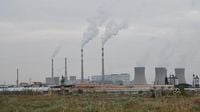The world has just received a sobering message from the United Nations’ top weather agency: carbon dioxide (CO2) levels in the Earth’s atmosphere soared to unprecedented heights last year, turbo-charging global warming and triggering a cascade of extreme weather events. This stark warning, delivered by the World Meteorological Organization (WMO) in Geneva on October 15, 2025, underscores a dangerous new chapter in the climate crisis—one where the planet’s natural defenses are faltering, and the pace of change is accelerating beyond anything seen in human history.
According to the WMO’s latest annual bulletin on greenhouse gases, the global average concentration of CO2 jumped by 3.5 parts per million (ppm) between 2023 and 2024. That’s the largest single-year increase since scientists began keeping records in 1957. For context, the average annual increase in the previous decade was just 2.4 ppm. Now, CO2 levels are higher than at any point in at least 800,000 years, a span that predates modern humans by a wide margin. As the WMO put it, these heat-trapping gases are “turbo-charging our climate and leading to more extreme weather.”
The reasons behind this alarming surge are both familiar and newly troubling. Emissions from burning coal, oil, and gas remain the primary culprits, but wildfires—supercharged by rising temperatures—are also pumping additional CO2 into the air. Even more concerning, the planet’s oceans and forests, which have long acted as natural carbon sponges, are losing their ability to absorb these emissions. WMO senior scientific officer Oksana Tarasova explained at a press conference, “Probably we started seeing the early indication of the limited capacity of the natural systems to actually absorb everything what we emit.”
Tarasova pointed specifically to the Amazon rainforest, often described as the lungs of the Earth. In 2024, the Amazon was hit by severe drought and heat, leaving its trees struggling to soak up carbon dioxide. “The sinks which we have, they started failing,” she said. “The Amazon indeed is emitting CO2, despite the general understanding that if you have a tree, it should absorb.” She added a chilling warning: “What also may happen is that at a certain point we may flip over the tipping point and then the whole Amazon forest just starts dying.”
Other greenhouse gases are also setting records. Methane and nitrous oxide, both of which are more potent than CO2 in trapping heat (though less abundant), reached their highest recorded concentrations in 2024. These gases, too, are largely the result of human activity—think agriculture, livestock, landfills, and fossil fuel production.
This surge in greenhouse gases is not just a scientific curiosity; it’s a direct threat to the global effort to curb climate change. The 2015 Paris Agreement set an ambitious goal: limit the rise in global average temperature to 1.5 degrees Celsius (2.7 degrees Fahrenheit) above pre-industrial levels. But the new WMO report casts serious doubt on the world’s ability to achieve that target. United Nations climate chief Simon Stiell has bluntly stated that the Earth is now on track for a 3 degrees Celsius (5.4 Fahrenheit) increase—double the Paris goal and enough to trigger catastrophic impacts worldwide.
Climate Analytics CEO Bill Hare didn’t mince words when reacting to the data. “Let there be no mistake, this is a very clear warning sign that the world is heading into an extremely dangerous state—and this is driven by the continued expansion of fossil fuel development, globally,” he said, according to the Associated Press. “I’m beginning to feel that this points to a slow-moving climate catastrophe unfolding in front of us.”
What’s especially worrisome, experts say, is the possibility that we’re witnessing the breakdown of the natural carbon cycle—a delicate balance in which forests and oceans absorb much of the CO2 emitted by humans, animals, and industry. Natural land sinks like the Amazon typically remove about a quarter of the carbon dioxide in the air, while oceans absorb another quarter. But as Tarasova noted, these systems are showing signs of strain. If they fail, the CO2 humans emit will linger in the atmosphere much longer, amplifying warming even if emissions were to stabilize.
The WMO’s bulletin was released just ahead of the U.N.’s annual climate conference, where leaders are expected to grapple with these grim findings. The agency called on policymakers to take urgent, sweeping action to reduce emissions. “Reducing emissions is therefore essential not just for our climate but also for our economic security and community well-being,” stressed WMO Deputy Secretary-General Ko Barrett. Yet, despite mounting evidence and increasingly dire warnings, progress remains sluggish. Hare pointed out that “very few countries have made new climate commitments to come anywhere near dealing with the gravity of the climate crisis.”
Meanwhile, some governments continue to advocate for more use of hydrocarbons—coal, oil, and gas—for energy production, even as local governments and businesses ramp up their own climate initiatives. This policy tug-of-war is playing out against a backdrop of rising public anxiety and a growing sense that the window for meaningful action is closing fast.
Data from the U.S. National Oceanic and Atmospheric Administration (NOAA) provides little comfort. Through June 2025, NOAA’s global data shows that CO2 levels are still rising at one of the highest rates on record, though not quite as sharply as during the 2023-2024 spike. Monthly readings from NOAA’s long-running monitoring site in Hawaii confirm the trend: atmospheric CO2 continues its relentless climb, with no sign of a sustained slowdown.
What does all this mean for ordinary people? The effects are already being felt in the form of more frequent and severe heatwaves, wildfires, droughts, and floods. Economic and social costs are mounting, from damaged crops and infrastructure to health crises and displacement. As Barrett put it, cutting emissions is not just about saving the climate—it’s about safeguarding the prosperity and well-being of communities everywhere.
As the world heads into another round of climate negotiations, the message from the scientific community is clear: the time for half-measures is over. The record-breaking rise in greenhouse gases is a flashing red light on the dashboard of the planet. Whether leaders will heed the warning, or allow the slow-moving catastrophe to gather speed, remains the defining question of our era.



